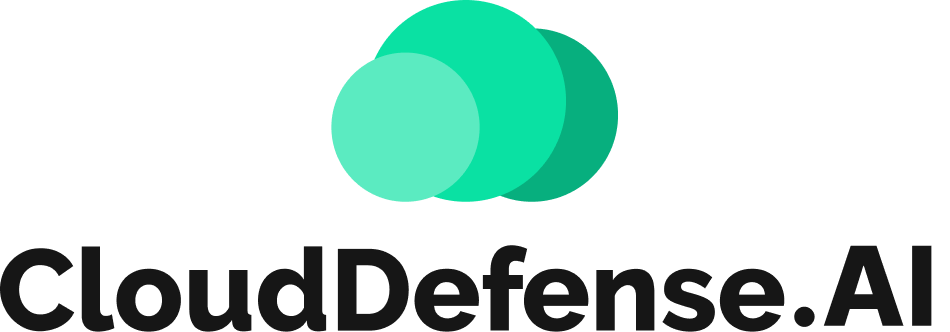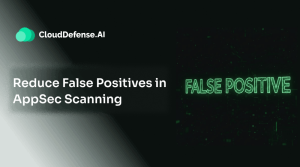Over the years, the software development approach has undergone significant evolution. Modern organizations are always in pursuit of achieving quicker and more secure software delivery, making the “shift-left” approach a primary pillar.
However, with increasing demand for precision in shift-left security and rapid cloud-native CI/CD workflow, the simple shift-left approach is struggling to keep up. Moreover, traditional shift-left strategies with legacy tools like SAST are bottlenecking and causing alert fatigue and a lack of context.
This is where modern AI SAST integration in CI/CD pipelines with QINA Clarity AI comes in helpful for enabling the “Shift-Left, Smarter” strategy. Many forward-looking organizations now choose to integrate QINA Clarity AI into your CI/CD pipeline to achieve seamless security testing and empower development teams with smarter shift-left practices. Clarity is a next-generation AI SAST that offers automated scanning, contextual insights, and a faster path to secure software delivery.
This article explains how the QINA Clarity AI tool will help organisations achieve the AI SAST integration in CI/CD and what benefits it has to offer.
The Problems with Traditional SAST for Shift-Left
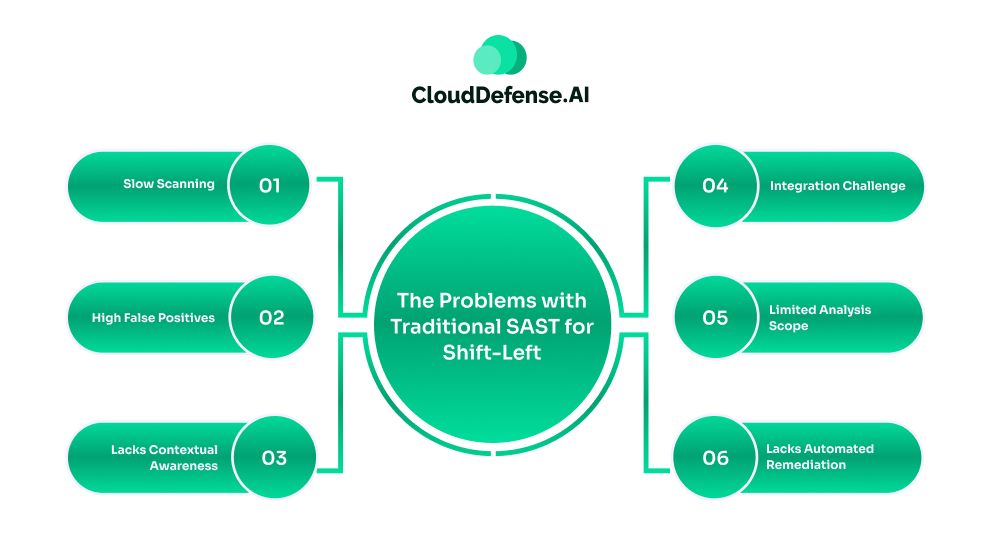
Traditional SAST tools have always been the backbone of application security testing. However, these tools are falling short in today’s high-velocity CI/CD pipeline with context-less scans, high false positives, and a lack of AI.
While the basic functionality of early scanning remains the same, the approach is becoming an obstacle. The primary problems include:
- Slow Scanning: Traditional SAST scanning processes are time-consuming and usually take a long time for complex codebases. Although they scan the codebase, they aren’t able to provide quick feedback when code is committed using AI-based code editors.
- High False Positives: A major reason many organizations are shifting from traditional SAST to automated security testing using QINA Clarity AI is due to high false positives. Traditional SAST is based on rule-based scanning and predefined pattern matching, raising alerts for the slightest deviation. It doesn’t understand the application context or business goal, resulting in high false positives in alerts.
- Lacks Contextual Awareness: Standard SAST tools aren’t based on AI or ML. As a result, they often fail to understand the code context, data flow, or exploitability of the flagged code. Importantly, they also lack the runtime context as they analyze code when they are not executed. Thus, it becomes cumbersome for teams to prioritise and fix the issue.
- Integration Challenge: On many occasions, traditional SAST can be difficult to integrate, disrupting the shift-left security in CI/CD workflow. Security teams require a good knowledge base to successfully integrate SAST tools.
- Limited Analysis Scope: Many organizations are looking past standard SAST tools because they can only natively scan the proprietary codebase. DevSec teams have to make changes in the configuration so that it can detect vulnerabilities in APIs, external repositories, and third-party libraries.
- Lacks Automated Remediation: Most SAST tools don’t offer any actionable and step-by-step guidance for remediation. When a vulnerability is detected, it only sends alerts without mentioning the location of the vulnerability in the line of code. It not only increases the complexity of triaging but also delays the security response.
QINA Clarity AI: Redefining Shift-Left Security
QINA Clarity AI is an advanced and next-gen AI-powered SAST tool that is designed to replace traditional SAST and redefine shift-left security. It is developed for the modern CI/CD pipeline to help developers analyze and identify vulnerabilities in the code before they commit it.
QINA Clarity AI brings a shift in how organizations approach AppSec security in the CI/CD pipeline. It addresses all the drawbacks of traditional SAST by leveraging AI, LLMs, and ML, and provides intelligent security with prioritized results.
What makes QINA Clarity AI stand out is its specialized 4-stage AI SAST pipeline. It offers exact context from all the security findings and provides smartly prioritised security alerts, filtering out all the false positives. It acts as an intelligent security layer in the CI/CD pipeline that not only accurately scans your source code but also external libraries, packages, and APIs.
Why Consider QINA Clarity AI for CI/CD Pipeline Integration?
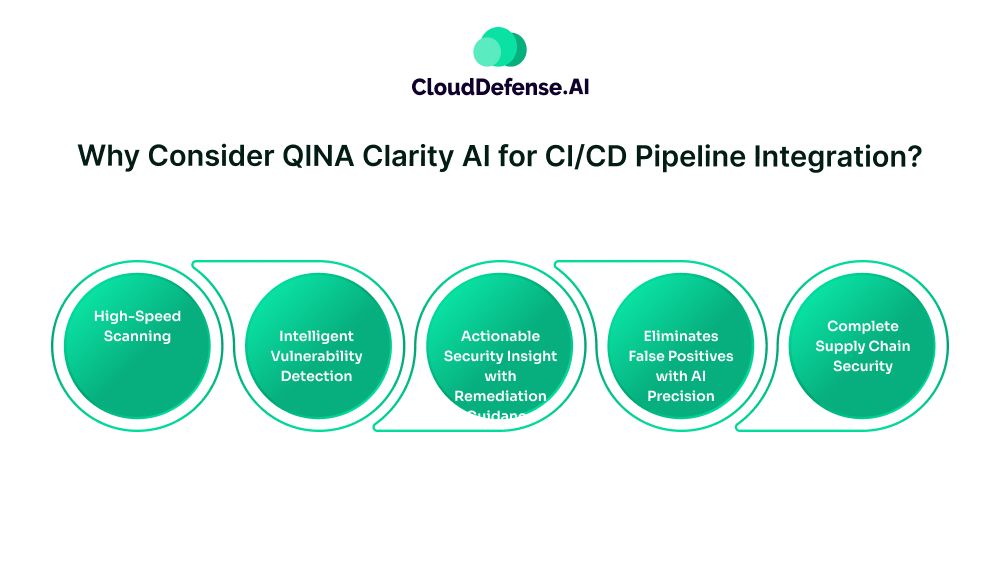
When it comes to AI SAST integration in CI/CD, QINA Clarity AI emerges as an automated choice for most modern organizations. It is just another SAST tool offering automated security testing, but a smart and AI-powered tool ensuring optimum code security.
Here are the primary advantages it offers when an organization integrates CI/CD pipeline for shift-left security:
- High-Speed Scanning: QINA Clarity AI holds the capability to scan a codebase within 2 minutes. The intelligent scanning process only scans the new or modified code segment in a pull request. The support of containerized architecture also serves as a key factor in quickening the scanning process. The quick scanning enables the tool to provide real-time feedback regarding code to developers, boosting the build process.
- Intelligent Vulnerability Detection: A major reason QINA Clarity AI is ideal for evolving automated security testing tasks is because of its intelligent vulnerability testing. It not only identifies the vulnerable line of code but also provides vulnerability context with reference tags like OWASP or SANS. It also provides a detailed risk analysis where Clarity AI showcases the business impact and exploitability of an identified security threat. The tool also showcases the complete visual code analysis for complete context.
- Actionable Security Insight with Remediation Guidance: Unlike standard SAST tools offering generic reports, QINA Clarity AI provides developers with reports having actionable intelligence. The insights are provided directly in the developer’s workflow, ensuring proactive shift-left security. The actionable insight also offers developers guided fixing steps, accelerating over remediation approach. It allows them to quickly solve issues or automate the remediation without context switching.
- Eliminates False Positives with AI Precision: QINA Clarity AI doesn’t involve rule-based pattern matching for vulnerability identification; rather, it utilizes a 4-stage contextual analysis. The AI and LLMs it utilizes are trained on millions of lines of code, allowing it to understand the context of a code request. All the security findings go through a 4-stage code analysis to provide developers with actual alerts that require immediate attention. It filters out all false positives, reducing alert fatigue and enabling developers to offer fast incident response.
- Complete Supply Chain Security: Supply chain security covering all the packages and APIs has become a necessity. QINA Clarity AI makes a comprehensive approach when it comes to securing the entire application stack. It not only identifies security issues in the codebase but also analyzes third-party dependencies and libraries for vulnerabilities. The security technologies also continuously monitor all the associated API and provide real-time alerts when a flaw is detected.
Integrate QINA Clarity AI into Your CI/CD Pipeline
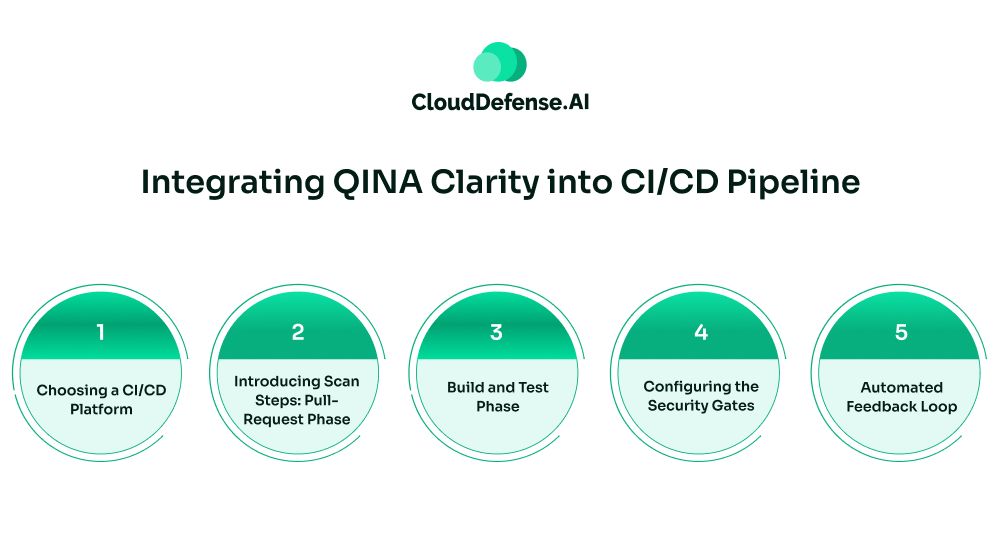
For organizations aiming for AI SAST integration in CI/CD, QINA Clarity AI is designed for seamless integration. It has been designed to enable organizations to achieve immediate ROI without hampering any native processes.
Here is a phased process of QINA Clarity AI integrating into the CI/CD pipeline:
Step 1: Choosing a CI/CD Platform
The first phase of AI SAST integration into CI/CD begins with selecting an appropriate CI/CD platform. QINA Clarity AI natively supports multiple platforms, GitHub Actions, Jenkins, GitLab CI/CD, and many more.
Step 2: Introducing Scan Steps: Pull-Request Phase
It is the initial phase of integration where the organization has to insert QINA Clarity AI for scanning in the CI/CD workflow. Security teams need to configure it for every pull request or push for every new code commit.
When a new pull request or push is made, the CI system triggers a webhook, which makes an API call to trigger the QINA Clarity AI scan. Clarity quickly analyzes the code change and provides a risk score.. Thus, Clarity makes sure every new line of code is analyzed before they are committed.
Step 3: Build and Test Phase
Once QINA Clarity provides the feedback and the pull request is merged, the continuous integration starts the build and test phase. After the code commit is merged, CI servers build the specific segment of the application.
However, before initiating the test phase, CI servers make queries to QINA Clarity AI regarding the type of test needed for the specific build phase. Clarity AI provides feedback regarding the code change and tests needed for the build.
Step 4: Configuring the Security Gates
After the test phase, developer and security teams must create a security gate to determine when a build should fail. Based on the severity of the vulnerability, the organization can configure the pipeline to fail the build.
For example, when a highly impactful security threat is detected in the test phase, the pipeline would completely fail the build. End-to-end test suites are initiated to test the changes. After the test, the build is deployed to the pre-production stage.
Step 5: Automated Feedback Loop
The developers also need to configure the feedback loop so that it can provide the scan result as feedback in the IDE on pull requests. The immediate feedback with contextual information and appropriate vulnerability tags enables developers to perform rapid remediation.
If a security issue is detected after release, the data regarding the threat is logged, and it is sent to Clarity AI through webhooks. It highlights the commit that led to the security threat. These feedback loops enable the tool to learn from the unknown issues and ensure better correlation of code commits that can also lead to production failure.
Best Practices for Integrating QINA Clarity AI
When organizations are implementing QINA Clarity AI for AI SAST integration in CI/CD, it would be ideal to follow certain best practices. These practices will maximise the effectiveness of QINA Clarity AI and provide better ROI:
- Implement the Tool at Key Integration Points: Organizations should begin the QINA Clarity AI integration to the CI/CD pipeline at key integration points. The tool should be integrated at pre-commit hooks, pull requests, and deployment gates to ensure optimum shift-left security.
- Utilize Security Policy-as-Code: It is best to automate the enforcement of security policy as code to maximize the benefit of QINA Clarity AI. The implementation will automatically block all the vulnerable deployment sections or fail builds upon security threat detection.
- Continuous Monitoring of the Tool: Automated security testing through QINA Clarity AI is not a one-time process, but rather a continuous security check. It is important for an organization to analyze the QINA Clarity AI’s security findings and overall performance regularly. It will enable the organization to make changes to configurations according to the security posture.
- Mandating Developer’s Training: While QINA Clarity AI simplifies the security efforts for developers, it is important that developers are trained continuously for secure coding practices. Developers should be trained on various trending security aspects along with insights from Clarity so that they can immediately respond to modern threats.
Bottom Line
QINA Clarity AI is redefining shift-left security in 2025 by making it smarter and efficient. It seamlessly integrates AI SAST in the CI/CD pipeline, helping with intelligent scanning, smart prioritisation, and automated remediation.
The tool supports integration with multiple CI/CD pipelines, which makes it easier for organizations to implement automated security testing without hampering development speed. It has enabled organizations to evolve their shift-left approach to a smarter model. The integration of QINA Clarity AI not only secures the pipeline but also empowers developers with contextual and actionable feedback. Ultimately, it optimizes resource consumption and enables the team to deliver software at the speed of DevOps. To learn more about QINA Clarity AI integration into the CI/CD pipeline, book a free demo.
